1997 CHEVROLET TAHOE oil filter
[x] Cancel search: oil filterPage 290 of 433
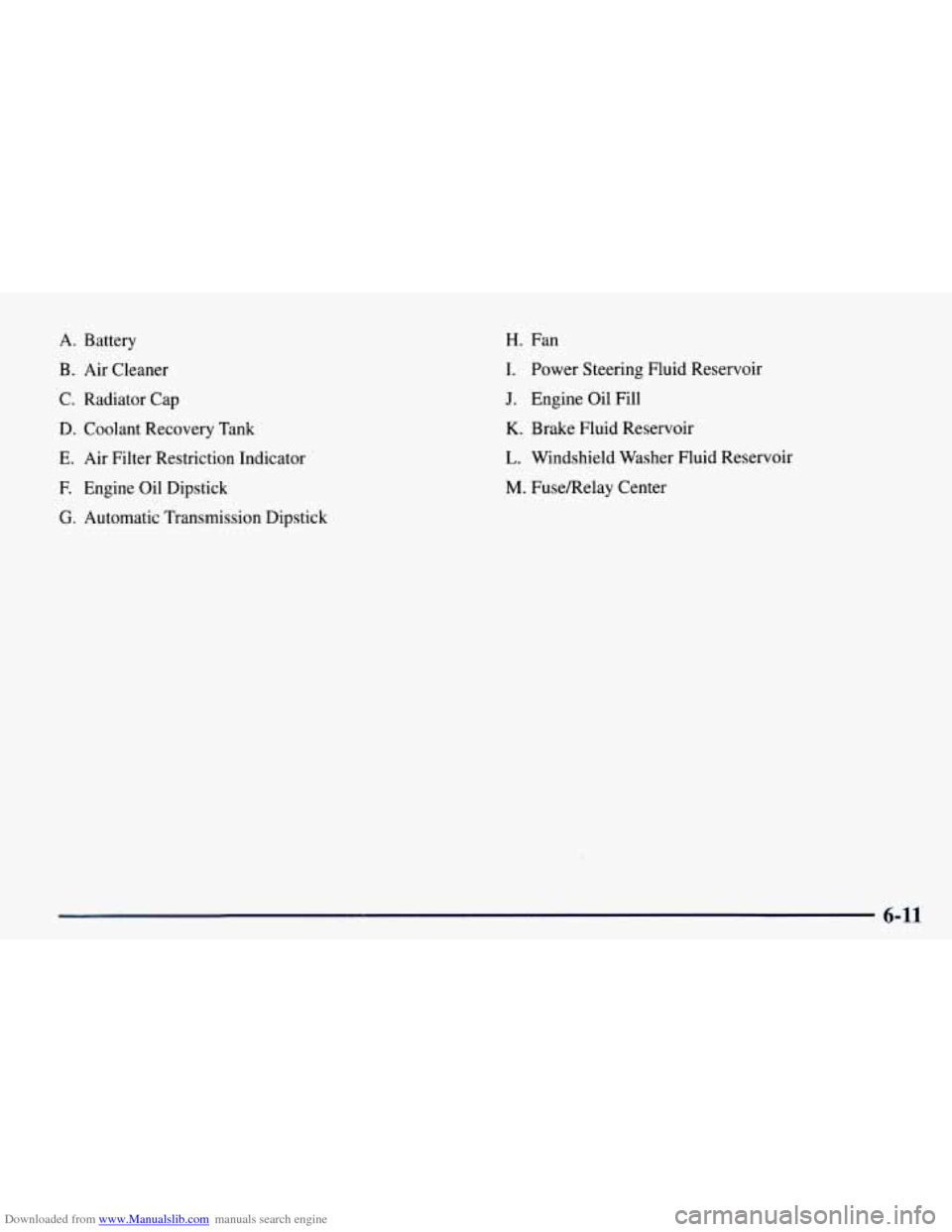
Downloaded from www.Manualslib.com manuals search engine A. Battery
B. Air Cleaner
C. Radiator Cap
D. Coolant Recovery Tank
E. Air Filter Restriction Indicator
F. Engine Oil Dipstick
G. Automatic Transmission Dipstick
H. Fan
I. Power Steering Fluid Reservoir
J. Engine Oil Fill
K. Brake Fluid Reservoir
L. Windshield Washer Fluid Reservoir
M. Fusemelay Center
6-11
Page 292 of 433
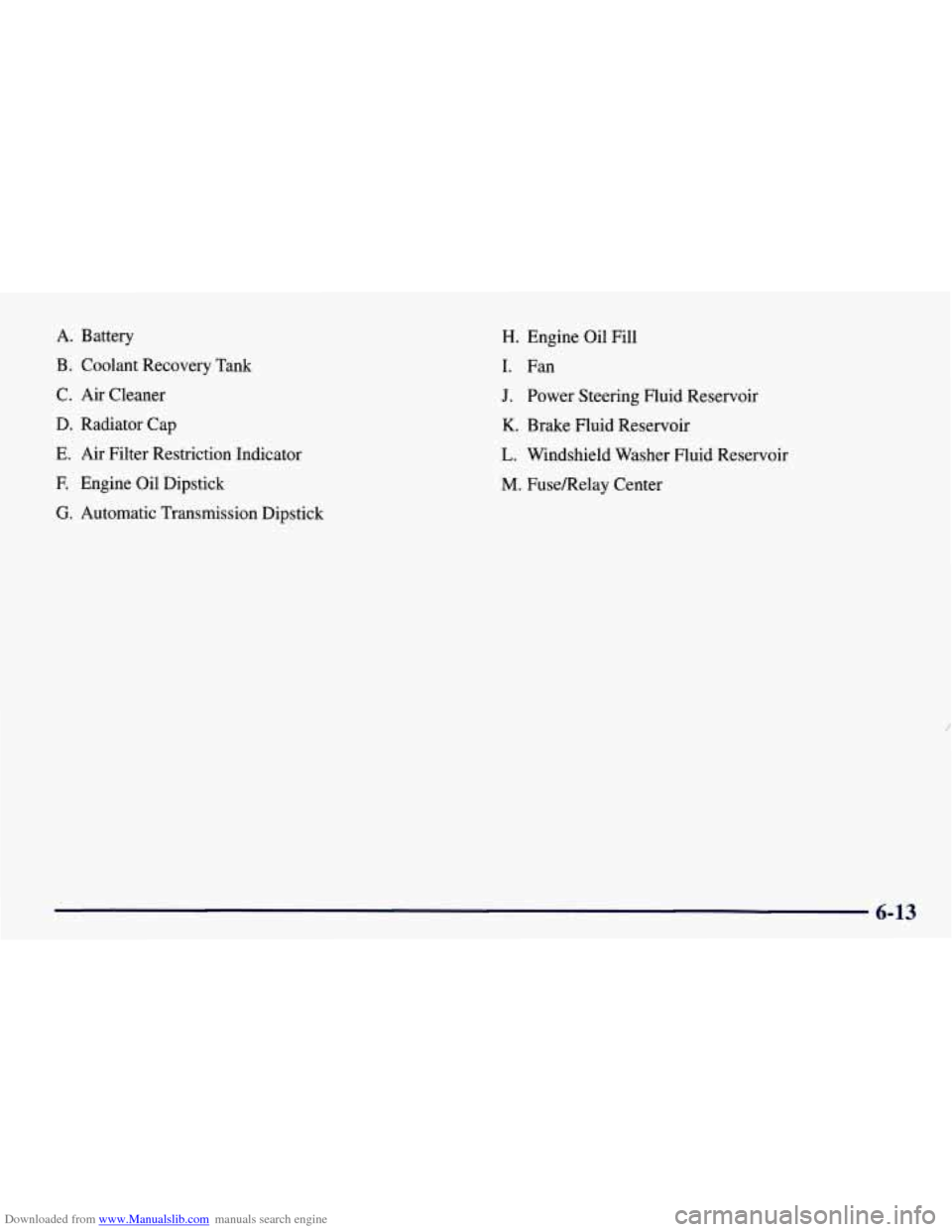
Downloaded from www.Manualslib.com manuals search engine A. Battery
B. Coolant Recovery Tank
C.
Air Cleaner
D. Radiator Cap
E. Air Filter Restriction Indicator
F. Engine Oil Dipstick
G. Automatic Transmission Dipstick
H. Engine Oil Fill
I. Fan
J. Power Steering Fluid Reservoir
K. Brake Fluid Reservoir
L. Windshield Washer Fluid Reservoir
M. FuseRelay Center
6-13
Page 296 of 433
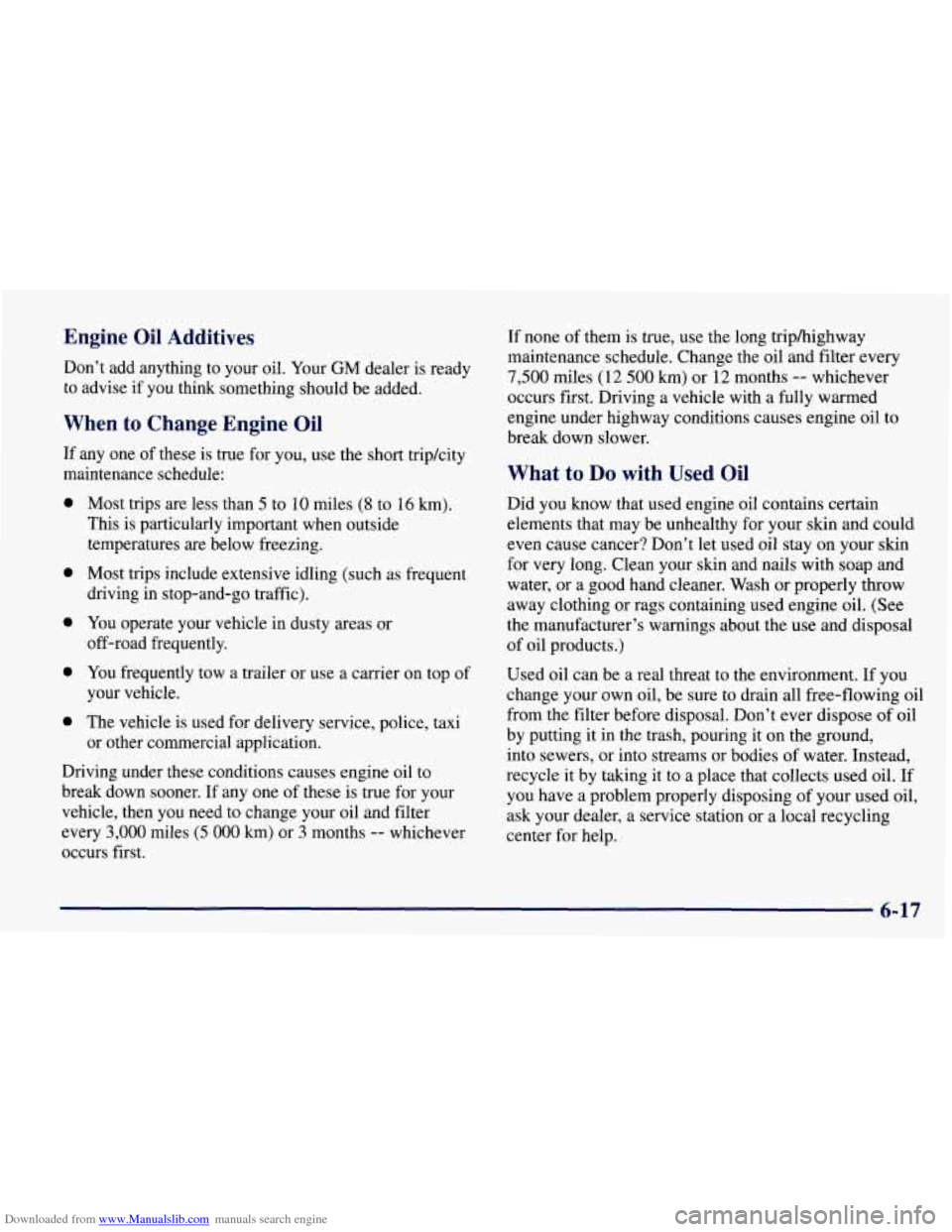
Downloaded from www.Manualslib.com manuals search engine Engine Oil Additives
Don’t add anything to your oil. Your GM dealer is ready
to advise if you think something should be added.
When to Change Engine Oil
If any one of these is true for you, use the short triplcity
maintenance schedule:
0
0
0
0
0
Most trips are less than 5 to 10 miles (8 to 16 km).
This is particularly important when outside
temperatures are below freezing.
Most trips include extensive idling (such as frequent
driving in stop-and-go traffic).
You operate your vehicle in dusty areas or
off-road frequently.
You frequently tow a trailer or use a carrier on top of
your vehicle.
The vehicle is used for delivery service, police, taxi
or other commercial application.
Driving under these conditions causes engine oil to
break down sooner. If any one of these is true for your
vehicle, then you need to change your oil and filter
every
3,000 miles (5 000 km) or 3 months -- whichever
occurs first. If
none
of them is true, use the long triphighway
maintenance schedule. Change the oil and filter every
7,500 miles (12 500 km) or 12 months -- whichever
occurs first. Driving a vehicle with a fully warmed
engine under highway conditions causes engine oil to
break down slower.
What to Do with Used Oil
Did you know that used engine oil contains certain
elements that may be unhealthy for your skin and could
even cause cancer? Don’t let used oil stay on your skin
for very long. Clean your skin and nails with soap and
water, or a good hand cleaner. Wash or properly throw
away clothing or rags containing used engine oil. (See
the manufacturer’s warnings about the use and disposal
of oil products.)
Used oil can be a real threat to the environment. If you
change your own oil, be sure to drain all free-flowing oil
from the filter before disposal. Don’t ever dispose of
oil
by putting it in the trash, pouring it on the ground,
into sewers, or into streams or bodies
of water. Instead,
recycle it by taking
it to a place that collects used oil. If
you have a problem properly disposing
of your used oil,
ask your dealer, a service station or a local recycling
center for help.
6-17
Page 299 of 433

Downloaded from www.Manualslib.com manuals search engine Refer to the Maintenance Schedule to determine when to
replace the
air filter. See “Owner Checks and Services”
in the Index.
A CAUTION:
Operating the engine with the air cleaner off can
cause you or others to be burned. The air cleaner
not only cleans the air, it stops flame if the engine
backfhes.
If it isn’t there, and the engine
backfires, you could be burned. Don’t drive with
it
off, and be careful working on the engine with
the
air cleaner off.
NOTICE:
If the air cleaner is off, a backfire can cause a
damaging engine fire. And, dirt can easily get
into your engine, which will damage
it. Always
have the air cleaner in place when you’re driving.
Automatic Transmission Fluid
When to Check and Change
A good time to check your automatic transmission fluid
level is when the engine oil is changed.
Change both the fluid and filter every
50,000 miles
(83 000 km) if the vehicle is mainly driven under one or
more
of these conditions:
0 In heavy city traffic where the outside temperature
regularly reaches
90°F (32 “C) or higher.
In hilly or mountainous terrain.
When doing frequent trailer towing.
0 Uses such as found in taxi, police or delivery service.
If you do not use your vehicle under any of these
conditions, the fluid and filter do not require changing.
See “Scheduled Maintenance Services” in the Index.
How to Check
Because this operation can be a little difficult, you
may choose to have this done at your
GM dealership
Service Department.
Page 349 of 433

Downloaded from www.Manualslib.com manuals search engine Normal Maintenance Replacement Parts -- Gasoline Engines
Replacement part numbers listed in this section are based on the latest information available at the time of printing,
and are subject to change. If a part listed in this manual is not the same as the part used in your vehicle when
it was
built, or if you have any questions, please contact your GM truck dealer.
Engine
“VORTEC” 5700
VIN R
Oil Filter AC Type PF1218f
Air Cleaner Filter AC Type A1300C
Spark Plugs
AC Type 4 1-932
Spark Plug Gap 0.060
in. (1.52 mm)
Fuel Filter AC Type GF626
Wiper Blades (Front) GM Part No. 22154886
Wiper Blade Type (Front) Trico
Wiper Blade Length (Front) 18 inches (45.0 cm)
Wiper Blade (Rear) GM Part
No. 22154396
Wiper Blade Type (Rear) Trico
Wiper Blade Length (Rear) 14 inches (35.5 cm)
“four-Wheel-Drive Vehicles
-- use a PF52 oil filter.
‘VORTEC” 7400
J
AC Type PF1218
AC Type A1300C AC Type 41-932
0.060 in. (1.52 mm)
AC Type GF626
GM Part
No. 22154886
Trico
18 inches
(45.0 cm)
GM Part No. 22154396
Trico
14 inches (35.5 cm)
Page 350 of 433

Downloaded from www.Manualslib.com manuals search engine Cooling System Capacity (Approximate)
After refill, the level must be rechecked. See “Cooling System” in the Index.
ENGINE VIN QTY Without Rear Heater
“VORTEC” 5700 R 17.5 Quarts (16.5 L)
“VORTEC” 7400 J 25 Quarts (23.5 L)
Crankcase Capacity (Approximate)
After refill, the level must be rechecked. See “Engine Oil” in the Index.
ENGINE VIN QUANTITY WITH FILTER?
“VORTEC” 5700 R 5 Quarts (4.8 L)
“VORTEC” 7400 J 7 Quarts (6.5 L)
?Oil filter should be changed at every oil change.
QTY With Rear Heater
20 Quarts (19 L)
27.5 Quarts (26 L)
6-71
Page 358 of 433
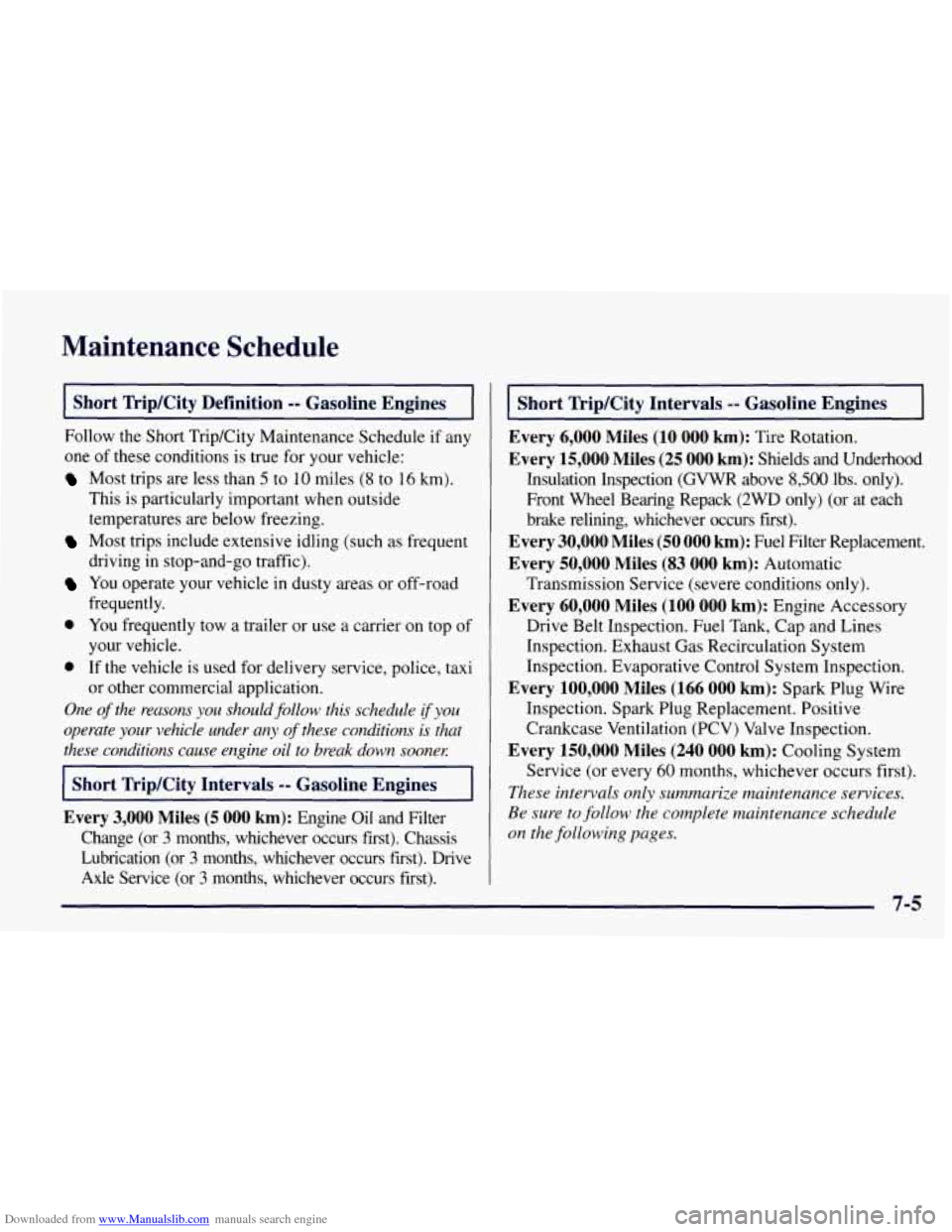
Downloaded from www.Manualslib.com manuals search engine Maintenance Schedule
Short Trip/City Definition -- Gasoline Engines .
Follow the Short Trip/City Maintenance Schedule if any
one of these conditions is true for your vehicle:
Most trips are less than 5 to 10 miles (8 to 16 km).
This is particularly important when outside
temperatures are below freezing.
driving in stop-and-go traffic).
frequently. your vehicle.
or other commercial application.
Most trips include extensive idling (such as frequent
You operate your vehicle in dusty areas or off-road
0 You frequently tow a trailer or use a carrier on top of
0 If the vehicle is used for delivery service, police, taxi
One of the reasons you should *follow this schedule if you
operate your vehicle under any of these conditions is that
these conditions cause engine oil to break down soonez
Short Trip/City Intervals -- Gasoline Engines
Every
3,000 Miles (5 000 km): Engine Oil and Filter
Change (or
3 months, whichever occurs first). Chassis
Lubrication (or
3 months, whichever occurs first). Drive
Axle Service (or
3 months, whichever occurs first).
Short Trip/City Intervals -- Gasoline Engines
Every 6,000 Miles
(10 000 km): Tire Rotation.
Every 15,000 Miles (25 000 km): Shields and Underhood
Insulation Inspection
(GVWR above 8,500 lbs. only).
Front Wheel Bearing Repack
(2WD only) (or at each
brake relining, whichever occurs first).
Every 30,000 Miles (50 000 km): Fuel Filter Replacement.
Every 50,000 Miles (83 000 km): Automatic
Transmission Service (severe conditions only).
Every 60,000 Miles (100 000 km): Engine Accessory
Drive Belt Inspection. Fuel Tank, Cap and Lines
Inspection. Exhaust Gas Recirculation System
Inspection. Evaporative Control System Inspection.
Every 100,000 Miles (166 000 km): Spark Plug Wire
Inspection. Spark Plug Replacement. Positive
Crankcase Ventilation
(PCV) Valve Inspection.
Service (or every 60 months, whichever occurs first).
Every 150,000 Miles (240 000 km): Cooling System
These intervals only summarize maintenance services.
Be sure to follow the complete maintenance schedule
on the following pages.
7-5
Page 359 of 433
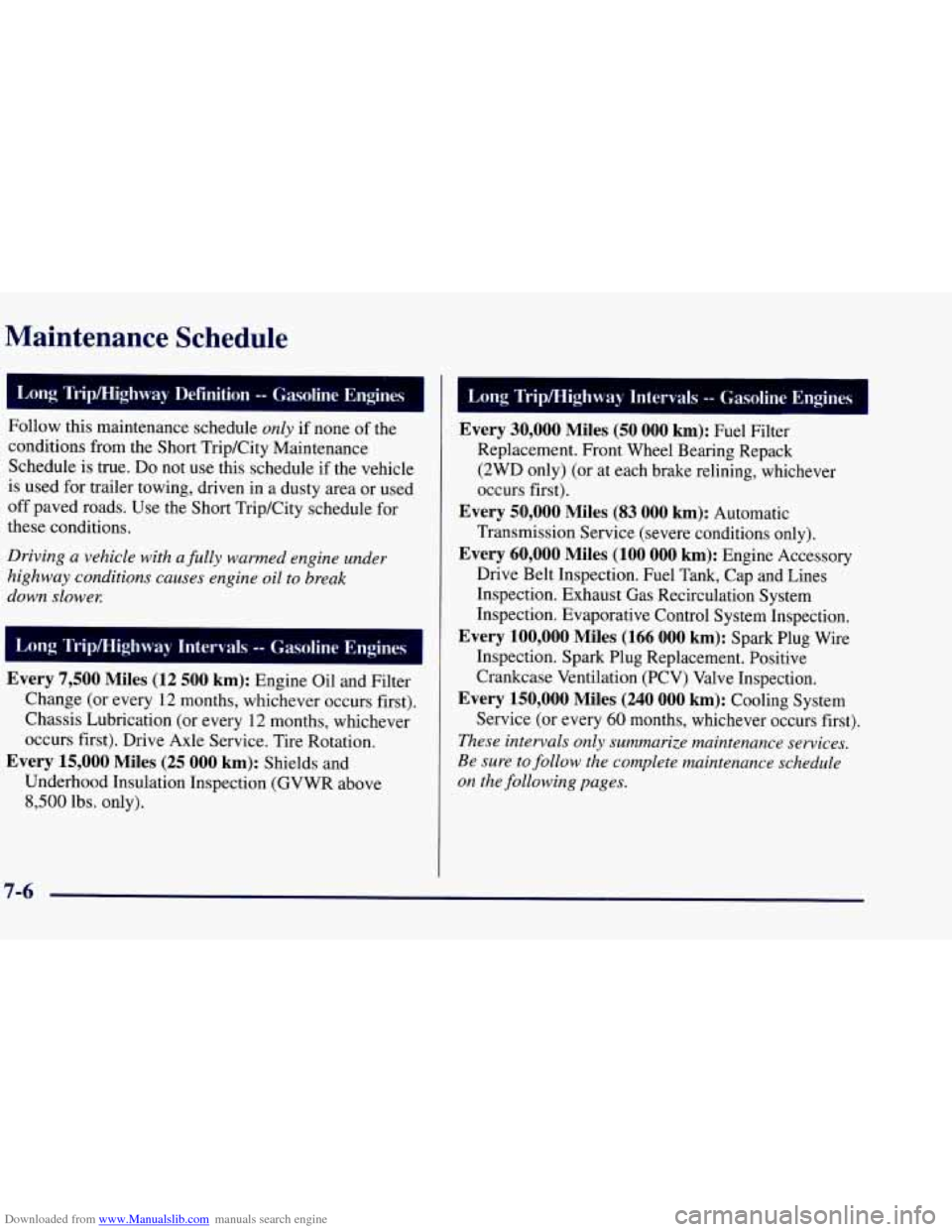
Downloaded from www.Manualslib.com manuals search engine Maintenance Schedule
I Long Trip/Highway Definition -- Gacoline Engines
Follow this maintenance schedule only if none of the
conditions from the Short Trip/City Maintenance
Schedule is true. Do not use this schedule if the vehicle
is used for trailer towing, driven in a dusty area or used
off paved roads. Use the Short Trip/City schedule for
these conditions.
Driving a vehicle with a fully warmed engine under
highway conditions causes engine oil to break
down slowel:
1 Long TripMighway Intervals -- Gasoline Engines I
Every 7,500 Miles (12 500 km): Engine Oil and Filter
Change (or every
12 months, whichever occurs first).
Chassis Lubrication (or every 12 months, whichever
occurs first). Drive Axle Service. Tire Rotation.
Underhood Insulation Inspection (GVWR above
8,500 lbs. only).
Every 15,000 Miles (25 000 km): Shields and
Long TripMighway Intervals -- Gasoline Engines
Every
30,000 Miles (50 000 km): Fuel Filter
Replacement. Front Wheel Bearing Repack
(2WD only) (or at each brake relining, whichever
occurs first).
Every 50,000 Miles (83 000 km): Automatic
Transmission Service (severe conditions only).
Every 60,000 Miles (100 000 km): Engine Accessory
Drive Belt Inspection. Fuel Tank, Cap and Lines
Inspection. Exhaust Gas Recirculation System
Inspection. Evaporative Control System Inspection.
Every 100,000 Miles (166 000 km): Spark Plug Wire
Inspection. Spark Plug Replacement. Positive
Crankcase Ventilation (PCV) Valve Inspection.
Every 150,000 Miles (240 000 km): Cooling System
Service (or every
60 months, whichever occurs first).
These intervals only summarize maintenance services.
Be sure to
follow the complete maintenance schedule
on the following pages.
7-6